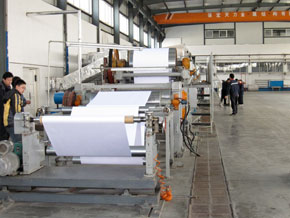Boise Inc., (BZ): An attractive paper company
My habit of finding companies that come in pairs is running true to form, although I think this could be the longest period between matching up the pairs. More than a year ago, I profiled Rayonier, a timber company that produces forest products and that got to take advantage of the black liquor tax credit, and now I have found Boise Inc. (BZ), a paper manufacturer that also got to take advantage of the black liquor tax credit.
 Boise Inc. is the third largest North American manufacturer of uncoated freesheet paper products. They make make paper cut to office size, and also produce paper suitable for use in envelopes or business forms or commercial printing, as well as labels. They also manufacture newsprint and corrugating medium for cardboard as well as other flexible packaging products. Most interesting, I think, is that they have a supply contract with OfficeMax, whereby OfficeMax will buy all the office paper that they can produce, in exchange for them offering a more stable pricing regime than the open market can provide. This arrangement, which falls due for renegotiation in 2012, accounts for 1/4 of Boise Inc.’s total office paper sales. Of course, the demand for paper and forms depends to a significant degree on the overall level of economic activity, and indeed the firm was forced to close down one of its facilities in 2008. Also there is a movement towards paperless offices and electronic forms, which the company sees as a source of long-term pressure. On the other hand, there is no such thing as electronic cardboard.
Boise Inc. is the third largest North American manufacturer of uncoated freesheet paper products. They make make paper cut to office size, and also produce paper suitable for use in envelopes or business forms or commercial printing, as well as labels. They also manufacture newsprint and corrugating medium for cardboard as well as other flexible packaging products. Most interesting, I think, is that they have a supply contract with OfficeMax, whereby OfficeMax will buy all the office paper that they can produce, in exchange for them offering a more stable pricing regime than the open market can provide. This arrangement, which falls due for renegotiation in 2012, accounts for 1/4 of Boise Inc.’s total office paper sales. Of course, the demand for paper and forms depends to a significant degree on the overall level of economic activity, and indeed the firm was forced to close down one of its facilities in 2008. Also there is a movement towards paperless offices and electronic forms, which the company sees as a source of long-term pressure. On the other hand, there is no such thing as electronic cardboard.
Boise Inc. also sells transport services to other users when they have the available capacity. I mention this not because it contributes a great deal to their bottom line–revenue from this field amounts to about $60 million a year out of $2 billion in total revenues–but because I like to see companies willing to pursue every avenue of potential profit. It reminds me of Compass Minerals leasing out a disused salt mine shaft to a records storage company.
 Turning now to the figures, the black liquor tax credit that the company earned in 2009 is no longer available and should not be taken into account in examining their future results. Removing that amount, plus removing the gains and losses they made from refinancing their debt in 2009, they had $142 million in operating earnings. Adding back in $131 million in depreciation and subtracting $77 million in capital expenditures produces estimated operating cash flow of $196 million. Interest paid in 2009 was $83 million, producing an interest coverage ratio of 2.36x, which leaves $113 million in estimated pretax cash flow, which after, say, 40% in state and federal taxes comes to $67.8 million in estimated free cash flow.
Turning now to the figures, the black liquor tax credit that the company earned in 2009 is no longer available and should not be taken into account in examining their future results. Removing that amount, plus removing the gains and losses they made from refinancing their debt in 2009, they had $142 million in operating earnings. Adding back in $131 million in depreciation and subtracting $77 million in capital expenditures produces estimated operating cash flow of $196 million. Interest paid in 2009 was $83 million, producing an interest coverage ratio of 2.36x, which leaves $113 million in estimated pretax cash flow, which after, say, 40% in state and federal taxes comes to $67.8 million in estimated free cash flow.
2010 showed even better results, although as Boise Inc. considers itself a cyclical company they may have derived some of this improved performance from a confluence of excellent conditions, as business activity improved somewhat over 2009 while cost of inputs did not. Sales increased by 6% and operating expenses by less than 2%. At any rate, for the first three quarters of 2010 (the fourth quarter report is due in a few weeks), we have $134 million in operating income. Add in 103 million in depreciation and take out 67 million in capital expenditures and we have operating cash flow of $170 million, as compared to $130 million for the same figure for the first three quarters of 2009. The firm paid $48 million in interest over the same period, producing an interest coverage ratio of 3.54x, leaving pretax cash flow of $122 million. If we multiply this figure by 4/3 to fill out the year and subtract 40% for taxes we get $97.6 million in estimated free cash flow for 2010. Based on current prices, we have a price/free cash flow ratio of 7, which I think is attractive.
In 2008, Boise Inc. did not do so well; they had operating earnings of $40 million and negative reported earnings and estimated free cash flow, owing in part to restructuring costs. In 2007, the predecessor company still produced about $90 million in estimated free cash flow.
Unfortunately, the calculated price/free cash flow ratio does not tell the whole story. Boise Inc. has outstanding 42 million shares worth of warrants at a price of $7.50. The company now has 80.5 million shares outstanding at a price of $8.51. I would say, taking one thing with another, that a free cash flow multiple of 9x would not be unreasonable for Boise Inc., and based on estimated free cash flow of $97.6 million for the year, the warrantless company is worth $878 million, or $10.91 per share. The warrants, if exercised, would add $316 million in cash, so if all the warrants are exercised the company will be worth $1.194 billion and have 122.5 million shares outstanding, which translates to a price target of $9.74. This stacks up attractively against the current price of $8.51.
 Turning to the balance sheet, significant debt levels do exist at this company, with $1.96 billion in total assets weighed against $750 million in long-term debt, $327 million in current liabilities and $227 million in “other.” As calculated above, though, interest is well-covered based on 2010 earnings, and indeed their 9% bonds due 2017 now trade at a premium price of 111 with a credit rating of BB, fairly high on the subinvestment grade levels. Long term debt levels have declined by $35 million since the beginning of 2010, and $226 million in 2009, thanks no doubt to the black liquor tax credit. I will also note that in the first three quarters of 2009, the company has built up an additional $100 million dollars in cash holdings. Now, many companies have been building up cash, but since Boise Inc. pays no dividend and produces enough cash to be able to afford one, I would be very interested to know what the firm’s plans are for that money, particularly with those warrants expiring in June of this year and ripe to be bought back.
Turning to the balance sheet, significant debt levels do exist at this company, with $1.96 billion in total assets weighed against $750 million in long-term debt, $327 million in current liabilities and $227 million in “other.” As calculated above, though, interest is well-covered based on 2010 earnings, and indeed their 9% bonds due 2017 now trade at a premium price of 111 with a credit rating of BB, fairly high on the subinvestment grade levels. Long term debt levels have declined by $35 million since the beginning of 2010, and $226 million in 2009, thanks no doubt to the black liquor tax credit. I will also note that in the first three quarters of 2009, the company has built up an additional $100 million dollars in cash holdings. Now, many companies have been building up cash, but since Boise Inc. pays no dividend and produces enough cash to be able to afford one, I would be very interested to know what the firm’s plans are for that money, particularly with those warrants expiring in June of this year and ripe to be bought back.
As a final note Boise Inc.’s financial statements are very lengthy and detailed. Clearly this is a firm that takes the disclosure requirements seriously. On the whole, I find that Boise Inc. is an attractive paper company at current prices, and definitely a candidate for portfolio inclusion.
under the debt covenants BZ can use roughly half of cumulative earnings (since the debt was issued) to buyback shares or pay dividends. After their 40c special dividend, and including earnings announced this quarter, that will leave them at most around 40M to buy back warrants, or only half the outstanding warrants… if they are allowed to buy back warrants.
where do you see what the bonds are trading at?
I personally am not too concerned if the warrants are exercised, as BZ could use the cash to make a smart acquisition. If the dilution really bothers them, they can always use the cash to pay a huge dividend or do buybacks. BZ has a lot of flexibility here and I think management is smart.
The FINRA has a bond screener on their website where I get most of my bond prices from.
http://cxa.marketwatch.com/finra/BondCenter/Default.aspx
[…] up to 10 (which would push the warrants to about $2.50) or even the faint hope it could be higher. Here is a more sophisticated analysis of the underlying stock, which the writer concludes remains […]